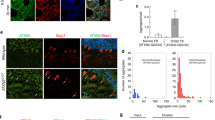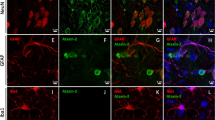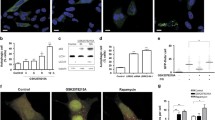Abstract
Spinocerebellar ataxia type 2 (SCA2), a rare polyglutamine neurodegenerative disorder caused by a CAG repeat expansion in the ataxin-2 gene, exhibits common cellular phenotypes with other neurodegenerative disorders, including oxidative stress and mitochondrial dysfunction. Here, we show that SCA2 patient cells exhibit higher levels of caspase-8- and caspase-9-mediated apoptotic activation than control cells, cellular phenotypes that we find to be exacerbated by reactive oxygen species (ROS) and inhibition of autophagy. We also suggest that oligomerization of mutant ataxin-2 protein is likely to be the cause of the observed cellular phenotypes by causing inhibition of autophagy and by inducing ROS generation. Finally, we show that removal of ataxin-2 oligomers, either by increasing autophagic clearance or by oligomer dissolution, appears to alleviate the cellular phenotypes. Our results suggest that oligomerized ataxin-2 and oxidative stress affect autophagic clearance in SCA2 cells, contributing to the pathophysiology, and that activation of autophagy or clearance of oligomers may prove to be effective therapeutic strategies.






Similar content being viewed by others
References
Takeuchi T, Nagai Y. Protein misfolding and aggregation as a therapeutic target for polyglutamine diseases. Brain Sci. 2017;7 Available from: http://www.ncbi.nlm.nih.gov/pubmed/29019918. Accessed 30 Sep 2019.
Sánchez I, Mahlke C, Yuan J. Pivotal role of oligomerization in expanded polyglutamine neurodegenerative disorders. Nature. 2003;421:373–9.
Durr A. Autosomal dominant cerebellar ataxias: Polyglutamine expansions and beyond. Lancet Neurol. 2010;9:885–94. https://doi.org/10.1016/S1474-4422(10)70183-6.
Todd TW, Lim J. Aggregation formation in the polyglutamine diseases: protection at a cost? Mol Cells. 2013;36:185–94 Available from: http://www.ncbi.nlm.nih.gov/pubmed/23794019. Accessed 30 Sep 2019.
Ravikumar B, Vacher C, Berger Z, Davies JE, Luo S, Oroz LG, et al. Inhibition of mTOR induces autophagy and reduces toxicity of polyglutamine expansions in fly and mouse models of Huntington disease. Nat Genet. 2004;36:585–95.
Ravikumar B, Sarkar S, Rubinsztein DC. Clearance of mutant aggregate-prone proteins by autophagy. Methods Mol Biol Humana Press. 2008;445:195–211.
Nixon RA, Yang D-S, Lee J-H. Neurodegenerative lysosomal disorders: a continuum from development to late age. Autophagy. 2008;4:590–9 Available from: http://www.ncbi.nlm.nih.gov/pubmed/18497567. Accessed 11 Aug 2015.
Nixon RA. The role of autophagy in neurodegenerative disease. Nat Med. 2013;19:983–97 Available from: http://www.ncbi.nlm.nih.gov/pubmed/23921753. Accessed 30 Sep 2019.
Starkov AA. The role of mitochondria in reactive oxygen species metabolism and signaling. Ann N Y Acad Sci. 2008;1147:37–52 Available from: http://www.pubmedcentral.nih.gov/articlerender.fcgi?artid=2869479&tool=pmcentrez&rendertype=abstract. Accessed 9 Apr 2015.
Wong E, Cuervo AM. Autophagy gone awry in neurodegenerative diseases. Nat Neurosci. 2010;13:805–11 Available from: http://www.ncbi.nlm.nih.gov/pubmed/20581817. Accessed 30 Sep 2019.
Kiriyama Y, Nochi H. The function of autophagy in neurodegenerative diseases. Int J Mol Sci, 16. 2015:26797–812 Available from: http://www.ncbi.nlm.nih.gov/pubmed/26569220. Accessed 30 Sep 2019.
Johri A, Beal MF. Mitochondrial dysfunction in neurodegenerative diseases. J Pharmacol Exp Ther. 2012;342:619–30 Available from: http://www.ncbi.nlm.nih.gov/pubmed/22700435. Accessed 30 Sep 2019.
Cornelius N, Wardman JH, Hargreaves IP, Neergheen V, Bie AS, Tümer Z, et al. Evidence of oxidative stress and mitochondrial dysfunction in spinocerebellar ataxia type 2 (SCA2) patient fibroblasts: effect of coenzyme Q10 supplementation on these parameters. Mitochondrion. 2017;34.
Kaminskyy VO, Zhivotovsky B. Free radicals in cross talk between autophagy and apoptosis. Antioxid Redox Signal. 2014;21:86–102 Available from: http://www.ncbi.nlm.nih.gov/pubmed/24359220. Accessed 6 Jul 2015.
Federico A, Cardaioli E, Da Pozzo P, Formichi P, Gallus GN, Radi E. Mitochondria, oxidative stress and neurodegeneration. J Neurol Sci. Elsevier B.V.; 2012;322:254–62. Available from: https://doi.org/10.1016/j.jns.2012.05.030. Accessed 6 Jul 2015
Inoue H, Tsukita K, Iwasato T, Suzuki Y, Tomioka M, Tateno M, et al. The crucial role of caspase-9 in the disease progression of a transgenic ALS mouse model. EMBO J. 2003;22:6665–74 Available from: http://www.ncbi.nlm.nih.gov/pubmed/14657037.
Mattson MP. Apoptosis in neurodegenerative disorders. Nat Rev Mol Cell Biol. 2000;1:120–9 Available from: http://www.ncbi.nlm.nih.gov/pubmed/11253364.. Accessed 30 Sep 2019.
Halbach MV, Stehning T, Damrath E, Jendrach M, Şen NE, Başak AN, et al. Both ubiquitin ligases FBXW8 and PARK2 are sequestrated into insolubility by ATXN2 PolyQ expansions, but only FBXW8 expression is dysregulated. PLoS One. 2015;10:e0121089 Available from: http://www.ncbi.nlm.nih.gov/pubmed/25790475. Accessed 30 Sep 2019.
Paul S, Dansithong W, Figueroa KP, Scoles DR, Pulst SM. Staufen1 links RNA stress granules and autophagy in a model of neurodegeneration. Nat Commun. 2018;9.
Bird TD. Hereditary ataxia overview. GeneReviews. 2015.
David DC. Aging and the aggregating proteome. Front Genet. 2012.
Fittschen M, Lastres-Becker I, Halbach MV, Damrath E, Gispert S, Azizov M, et al. Genetic ablation of ataxin-2 increases several global translation factors in their transcript abundance but decreases translation rate. Neurogenetics. 2015;16:181–92.
Lastres-Becker I, Nonis D, Eich F, Klinkenberg M, Gorospe M, Kötter P, et al. Mammalian ataxin-2 modulates translation control at the pre-initiation complex via PI3K/mTOR and is induced by starvation. Biochim Biophys Acta. 2016;1862:1558–69 Available from: http://www.ncbi.nlm.nih.gov/pubmed/27240544. Accessed 30 Sep 2019.
Satterfield TF, Pallanck LJ. Ataxin-2 and its Drosophila homolog, ATX2, physically assemble with polyribosomes. Hum.Mol.Genet. 2006:2523–32.
Kasumu A, Bezprozvanny I. Deranged calcium signaling in Purkinje cells and pathogenesis in spinocerebellar ataxia 2 (SCA2) and other ataxias. Cerebellum. 2012;11:630–9 Available from: http://www.pubmedcentral.nih.gov/articlerender.fcgi?artid=3257360&tool=pmcentrez&rendertype=abstract. Acessed 9 Apr 2015.
Liu J, Tang TS, Tu H, Nelson O, Herndon E, Huynh DP, et al. Deranged calcium signaling and neurodegeneration in spinocerebellar ataxia type 2. J Neurosci. 2009;29:9148–62.
Nonhoff U, Ralser M, Welzel F, Piccini I, Balzereit D, Yaspo M-L, et al. Ataxin-2 interacts with the DEAD/H-box RNA helicase DDX6 and interferes with P-bodies and stress granules. Mol Biol Cell. 2007;18:1385–96 Available from: http://www.ncbi.nlm.nih.gov/pubmed/17392519. Accessed 30 Sep 2019.
Wang X, Chen XJ. A cytosolic network suppressing mitochondria-mediated proteostatic stress and cell death. Nature. 2015;524:481–4.
Seidel G, Meierhofer D, Şen NE, Guenther A, Krobitsch S, Auburger G. Quantitative global proteomics of yeast PBP1 deletion mutants and their stress responses identifies glucose metabolism, mitochondrial, and stress granule changes. J Proteome Res. 2017;16:504–15.
Meierhofer D, Halbach M, Şen NE, Gispert S, Auburger G. Ataxin-2 (Atxn2)-knock-out mice show branched chain amino acids and fatty acids pathway alterations. Mol Cell Proteomics. 2016;15:1728–39 Available from: http://www.ncbi.nlm.nih.gov/pubmed/26850065. Accessed 30 Sep 2019.
Kato M, Yang Y-S, Sutter BM, Wang Y, McKnight SL, Tu BP. Redox state controls phase separation of the yeast ataxin-2 protein via reversible oxidation of its methionine-rich low-complexity domain. Cell. 2019;177:711–721.e8 Available from: http://www.ncbi.nlm.nih.gov/pubmed/30982603. Accessed 4 Oct 2019.
Orr HT, Zoghbi HY. Trinucleotide repeat disorders. Annu. Rev. Neurosci. 2007:575–621.
Imbert G, Saudou F, Yvert G, Devys D, Trottier Y, Garnier JM, et al. Cloning of the gene for spinocerebellar ataxia 2 reveals a locus with high sensitivity to expanded CAG/glutamine repeats. Nat Genet. 1996:285–91.
Pulst SM, Nechiporuk A, Nechiporuk T, Gispert S, Chen XN, Lopes-Cendes I, et al. Moderate expansion of a normally biallelic trinucleotide repeat in spinocerebellar ataxia type 2. Nat Genet. 1996:269–76.
Lastres-Becker I, Brodesser S, Lütjohann D, Azizov M, Buchmann J, Hintermann E, et al. Insulin receptor and lipid metabolism pathology in ataxin-2 knock-out mice. Hum Mol Genet. 2008;17:1465–81 Available from: http://www.ncbi.nlm.nih.gov/pubmed/18250099. Accessed 30 Sep 2019.
Pfeffer M, Gispert S, Auburger G, Wicht H, Korf H-W. Impact of Ataxin-2 knock out on circadian locomotor behavior and PER immunoreaction in the SCN of mice. Chronobiol Int. 2017;34:129–37 Available from: http://www.ncbi.nlm.nih.gov/pubmed/27791392. Accessed 30 Sep 2019.
Gardiner SL, Milanese C, Boogaard MW, Buijsen RAM, Hogenboom M, Roos RAC, et al. Bioenergetics in fibroblasts of patients with Huntington disease are associated with age at onset. Neurol Genet. 2018;4:e275 Available from: http://www.ncbi.nlm.nih.gov/pubmed/30338295. Accessed 30 Sep 2019.
Fernandez-Estevez MA, Casarejos MJ, Sendon JL, Caldentey JG, Ruiz C, Gomez A, et al. Trehalose reverses cell malfunction in fibroblasts from normal and Huntington’s disease patients caused by proteosome inhibition. PLoS One. 2014;9.
Schmitz-Hubsch T, du Montcel ST, Baliko L, Berciano J, Boesch S, Depondt C, et al. Scale for the assessment and rating of ataxia: development of a new clinical scale. Neurology. 2006:1717–20.
Nielsen TT, Svenstrup K, Budtz-Jørgensen E, Eiberg H, Hasholt L, Nielsen JE. ATXN2 with intermediate-length CAG/CAA repeats does not seem to be a risk factor in hereditary spastic paraplegia. J Neurol Sci. 2012;321:100–2.
Huynh DP, Yang HT, Vakharia H, Nguyen D, Pulst SM. Expansion of the polyQ repeat in ataxin-2 alters its Golgi localization, disrupts the Golgi complex and causes cell death. Hum Mol Genet. 2003:1485–96.
Hart MP, Gitler AD. ALS-associated ataxin 2 polyQ expansions enhance stress-induced caspase 3 activation and increase TDP-43 pathological modifications. J Neurosci. 2012;32:9133–42 Available from: http://www.ncbi.nlm.nih.gov/pubmed/22764223. Accessed 1 Oct 2019.
Krajewski S, Krajewska M, Ellerby LM, Welsh K, Xie Z, Deveraux QL, et al. Release of caspase-9 from mitochondria during neuronal apoptosis and cerebral ischemia. Proc Natl Acad Sci U S A. 1999;96:5752–7.
Green DR, Reed JC. Mitochondria and apoptosis. Science. 1998;281:1309–12.
Laussmann MA, Passante E, Düssmann H, Rauen JA, Würstle ML, Delgado ME, et al. Proteasome inhibition can induce an autophagy-dependent apical activation of caspase-8. Cell Death Differ. 2011;18:1584–97.
Pan J-A, Ullman E, Dou Z, Zong W-X. Inhibition of protein degradation induces apoptosis through a microtubule-associated protein 1 light chain 3-mediated activation of caspase-8 at intracellular membranes. Mol Cell Biol. 2011;31:3158–70.
Almaguer-Mederos LE, Almaguer-Gotay D, Aguilera-Rodríguez R, González-Zaldívar Y, Cuello-Almarales D, Laffita-Mesa J, et al. Association of glutathione S-transferase omega polymorphism and spinocerebellar ataxia type 2. J Neurol Sci. 2017;372:324–8.
Myeku N, Figueiredo-Pereira ME. Dynamics of the degradation of ubiquitinated proteins by proteasomes and autophagy: association with sequestosome 1/p62. J Biol Chem. 2011;286:22426–40.
Redmann M, Benavides GA, Berryhill TF, Wani WY, Ouyang X, Johnson MS, et al. Inhibition of autophagy with bafilomycin and chloroquine decreases mitochondrial quality and bioenergetic function in primary neurons. Redox Biol. 2017;11:73–81.
Yang YS, Kato M, Wu X, Litsios A, Sutter BM, Wang Y, et al. Yeast ataxin-2 forms an intracellular condensate required for the inhibition of TORC1 signaling during respiratory growth. Cell. 2019;177:697–710.e17.
DeMille D, Badal BD, Evans JB, Mathis AD, Anderson JF, Grose JH. PAS kinase is activated by direct SNF1-dependent phosphorylation and mediates inhibition of TORC1 through the phosphorylation and activation of Pbp1. Mol Biol Cell. 2015;26:569–82.
Floto RA, Sarkar S, Perlstein EO, Kampmann B, Schreiber SL, Rubinsztein DC. Small molecule enhancers of rapamycin-induced TOR inhibition promote autophagy, reduce toxicity in Huntington’s disease models and enhance killing of mycobacteria by macrophages. Autophagy. 2007;3:620–2 Available from: http://www.ncbi.nlm.nih.gov/pubmed/17786022. Accessed 1 Oct 2019.
Zhang X, Chen S, Song L, Tang Y, Shen Y, Jia L, et al. MTOR-independent, autophagic enhancer trehalose prolongs motor neuron survival and ameliorates the autophagic flux defect in a mouse model of amyotrophic lateral sclerosis. Autophagy. 2014;10:588–602.
Sarkar S, Davies JE, Huang Z, Tunnacliffe A, Rubinsztein DC. Trehalose, a novel mTOR-independent autophagy enhancer, accelerates the clearance of mutant huntingtin and α-synuclein. J Biol Chem. 2007;282:5641–52.
Sarkar S, Ravikumar B, Floto RA, Rubinsztein DC. Rapamycin and mTOR-independent autophagy inducers ameliorate toxicity of polyglutamine-expanded huntingtin and related proteinopathies. Cell Death Differ. 2009:46–56.
Orr HT. Hereditary ataxia. An unfolded protein. Lancet (London, England). 2001;358(Suppl):S35 Available from: http://www.ncbi.nlm.nih.gov/pubmed/11784584. Accessed 1 Oct 2019.
Balch WE, Morimoto RI, Dillin A, Kelly JW. Adapting proteostasis for disease intervention. Science. 2008;319:916–9 Available from: http://www.ncbi.nlm.nih.gov/pubmed/18276881. Accessed 1 Oct 2019.
Zhang X, Smith DL, Meriin AB, Engemann S, Russel DE, Roark M, et al. A potent small molecule inhibits polyglutamine aggregation in Huntington’s disease neurons and suppresses neurodegeneration in vivo. Proc Natl Acad Sci U S A. 2005;102:892–7 Available from: http://www.ncbi.nlm.nih.gov/pubmed/15642944. Accessed 2 Oct 2019.
Frid P, Anisimov SV, Popovic N. Congo red and protein aggregation in neurodegenerative diseases. Brain Res Rev. 2007;53:135–60 Available from: http://www.ncbi.nlm.nih.gov/pubmed/16959325. Accessed 15 Oct 2019.
Pulst S-M, Huynh DP, Figueroa K, Hoang N. Nuclear localization or inclusion body formation of ataxin-2 are not necessary for SCA2 pathogenesis in mouse or human. Nat Genet. 2000;26:44–50 Available from: http://www.ncbi.nlm.nih.gov/pubmed/10973246. Accessed 11 Feb 2017.
Casarejos MJ, Solano RM, Gómez A, Perucho J, de Yébenes JG, Mena MA. The accumulation of neurotoxic proteins, induced by proteasome inhibition, is reverted by trehalose, an enhancer of autophagy, in human neuroblastoma cells. Neurochem Int. 2011;58:512–20 Available from: http://www.ncbi.nlm.nih.gov/pubmed/21232572. Accessed 1 Oct 2019.
Bhat AH, Dar KB, Anees S, Zargar MA, Masood A, Sofi MA, et al. Oxidative stress, mitochondrial dysfunction and neurodegenerative diseases; a mechanistic insight. Biomed Pharmacother. 2015;74:101–10 Available from: http://www.ncbi.nlm.nih.gov/pubmed/26349970. Accessed 1 Oct 2019.
Soto C. Unfolding the role of protein misfolding in neurodegenerative diseases. Nat Rev Neurosci. 2003;4:49–60 Available from: http://www.ncbi.nlm.nih.gov/pubmed/12511861. Accessed 1 Oct 2019.
Beal MF. Mitochondria, free radicals, and neurodegeneration. Curr Opin Neurobiol. 1996;6:661–6 Available from: http://www.ncbi.nlm.nih.gov/pubmed/8937831. Accessed 5 May 2015.
Ding Q, Keller JN. Proteasome inhibition in oxidative stress neurotoxicity: implications for heat shock proteins. J Neurochem. 2001;77:1010–7 Available from: http://www.ncbi.nlm.nih.gov/pubmed/11359866. Accessed 1 Oct 2019.
Bartolomé A, García-Aguilar A, Asahara S-I, Kido Y, Guillén C, Pajvani UB, et al. MTORC1 regulates both general autophagy and mitophagy induction after oxidative phosphorylation uncoupling. Mol Cell Biol. 2017;37 Available from: http://www.ncbi.nlm.nih.gov/pubmed/28894028. Accessed 1 Oct 2019.
Funding
The authors wish to acknowledge the funding contributions of the Research Board at Rigshospitalet and the Novo Nordisk Foundation.
Author information
Authors and Affiliations
Contributions
JHW, EEH, AGM, JEN, and TTN designed the experiments. JHW and EEH performed the experiments and analyzed the corresponding results. JHW wrote the paper with editing and consultation from EEH, AGM, JEN, and TTN.
Corresponding author
Ethics declarations
Conflict of Interest
The authors declare that they have no conflict of interest.
Additional information
Publisher’s Note
Springer Nature remains neutral with regard to jurisdictional claims in published maps and institutional affiliations.
Rights and permissions
About this article
Cite this article
Wardman, J.H., Henriksen, E.E., Marthaler, A.G. et al. Enhancement of Autophagy and Solubilization of Ataxin-2 Alleviate Apoptosis in Spinocerebellar Ataxia Type 2 Patient Cells. Cerebellum 19, 165–181 (2020). https://doi.org/10.1007/s12311-019-01092-8
Published:
Issue Date:
DOI: https://doi.org/10.1007/s12311-019-01092-8




